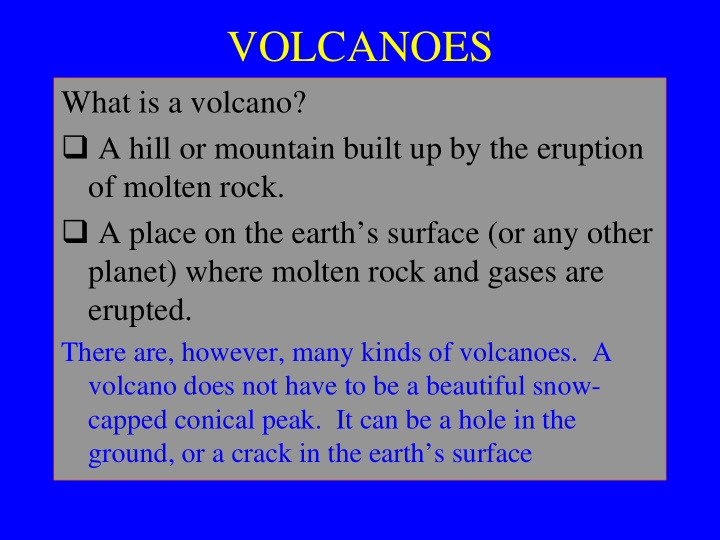



VOLCANOES What is a volcano? A hill or mountain built up by the eruption of molten rock. A place on the earth’s surface (or any other planet) where molten rock and gases are erupted. There are, however, many kinds of volcanoes. A volcano does not have to be a beautiful snow- capped conical peak. It can be a hole in the ground, or a crack in the earth’s surface
This is what we tend to think of when we think of volcanoes – beautiful, snow-capped, conical peaks. In this case Mount St. Helens prior to its 1980 eruption.
This type of volcano is called a stratovolcano. This is because the conical cones are built up of layers (strata) of lava and volcanic ash. Here are a couple of other stratovolcanoes. Mount Shasta, Cascades Mount Hood, Cascades (also a composite volcano)
Cinder Cones Cinder cones, Haleakala volcano, Hawaii Ojo de Agua, Mexico These volcanoes are often referred to as monogenetic volcanoes. This is because, unlike stratovolcanoes they usually only erupt once.
more cinder cones Paricutin Volcano, Mexico, Surtsey Volcano, Iceland, erupted out of a corn field erupting out of the sea in 1943. in 1963.
Shield Volcanoes Snow-covered Mauna Loa The summit crater (or Volcano, Hawaii. The world’s caldera) of Mauna Loa largest active volcano, rising 13,690 ft above sea level and 33,000 ft from the ocean floor.
Mauna Kea Volcano, Hawaii The summit crater (caldera) of Kilauea Volcano, Hawaii Unlike stratovolcanoes that are composed of viscous lavas and ash, shield volcanoes are made of fluid basalt lavas flows, that flow much further, thus giving them their shield-like shape.
Newberry Volcano, a shield volcano in Oregon. From the summit you can see that it has a large crater complete with lava flows and cinder cones.
The mother of all volcanoes! This is Olympus Mons, a giant shield volcano on Mars It is believed to be the largest volcano in the solar system. (Note the entire island of Hawaii would fit in its caldera)
Holes in the Ground! Vitti, an explosion crater Zuni Maar, New Mexico that erupted in Iceland in 1720 AD. Maars and explosion craters are produced when hot magma (usually basalt) reacts violently with shallow water, or water- soaked ground.
Crater Lake, Oregon This is a different kind of hole in the ground. Crater Lake is what is now left of a large stratovolcano that blew itself to bits 6,845 years ago.
Long Valley Caldera, California Some volcanic holes in the ground are just too big to be appreciated! Long Valley Caldera (30 x 15 km) formed by collapse about 760,000 years ago, following a gigantic explosive eruption. The last eruption here was 600 years ago.
Cracks in the ground (fissures) Lava and steam erupting from cracks at Krafla, Iceland in 1981 Lava flows from cracks in the Snake River Plain, Idaho.
Lava erupting from cracks (fissure eruptions) can produce huge thick piles of lava, such as these here in Eastern Iceland.
Where do volcanoes occur? PLATE MARGINS • Spreading Margins – Mid-Ocean Ridges e.g. Iceland – Rifting Continents e.g. E. Africa Rift • Converging Margins – Island Arcs e.g. Aleutians, Japan – Continental margins e.g. Cascades, Andes PLATE INTERIORS • Oceanic Plates e.g. Hawaii, Reunion • Continental Plates e.g. Yellowstone
Some Volcano Facts The total number of recognizable volcanoes is about 10,000 ACTIVE – volcanoes known to have erupted during historical times. Total Number = 529 DORMANT – volcanoes that have not erupted during historical times, but will probably erupt again. Total Number = 1,340 EXTINCT – volcanoes that are unlikely to erupt again.
more volcano facts…… About 500 volcanoes are currently active. Typically there are about 5 – 10 volcanoes erupting every month (about 50/year). About 262,000 people have been killed by volcanoes since 1600A.D. (this averages out at one person per year per volcano!).
The Major Killers Year Volcano Deaths Cause 1783 Laki, Iceland 9,340 (mostly starvation) 1815 Tambora, Indonesia 92,000 (80,000 starvation) 1883 Krakatao, Indonesia 36,000 (mostly tsunami) 1902 Mt. Pelee, Martinique 29,000 (ash flows) 1985 Nevada del Ruiz Colombia 22,000 (mud flows)
Repose Period This is the time interval between successive eruptions. It can range from minutes to thousands of years! In general the longer the repose period the more explosive and dangerous the eruption.
A Simple Guide to Volcanic Rocks Gases = water, Produced by MAGMA sulfur and fluorine melting in the molten rock and gases crust or mantle dissolved gases Low gas content, High gas content, quiet eruptions explosive eruptions Lava Pyroclastics small large (fire broken) Volcanic Ash (Tephra) Bombs very hot (Ash clouds, Ignimbrites nuees ardentes)
Silica Typical Viscosity Gas Rocks Content Content (SiO 2 ) BASALT < 54 % Low Low ANDESITE 54 – 64 % DACITE 64 – 70 % RHYOLITE 70 – 76 % High High Consequently,rhyolite and dacite eruptions tend to be more explosive than basalt and andesite eruptions.
Melting in the Mantle Temperature C Depth (Pressure) Partially Solid Melting Molten B Mantle begins Mantle Ascending Mantle Melting buoyant A Curve mantle
Building Volcanoes
A more complex example NOTE - melts produced in both the mantle and the crust result in a wide range of magma types, including those that produce explosive eruptions.
An even more complex example Magma is produced both by melting the down-going oceanic crust, and by “fluxing” the overlying asthenosphere with water driven off the down-going oceanic crust.
Recommend
More recommend